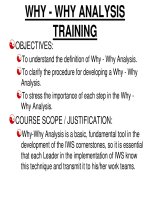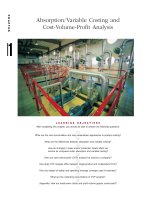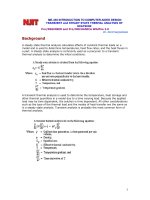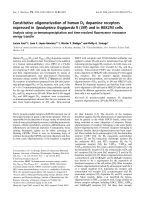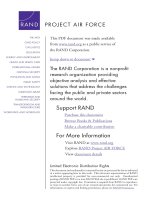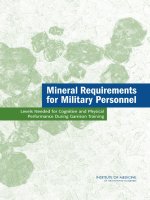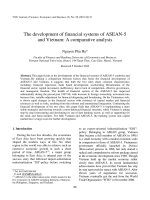60571944 hazard and operability HAZOP hazard analysis training
Bạn đang xem bản rút gọn của tài liệu. Xem và tải ngay bản đầy đủ của tài liệu tại đây (5.47 MB, 106 trang )
Hazard and Operability
(HAZOP)& Hazard Analysis
Training
0
HAZOP
Fundamental
1
A scenario…
• You and your family are on a road trip
by using a car in the middle of the
night. You were replying a text
message while driving at 100 km/h and
it was raining heavily. The car hits a
deep hole and one of your tire blows.
You hit the brake, but due to slippery
road and your car tire thread was thin,
the car skidded and was thrown off the
road.
2
Points to ponder
What is the cause of the accident?
What is the consequence of the event?
What can we do to prevent all those things to
happen in the first place?
(5 minutes for brainstorming ideas)
3
What other possible accidents
might happen on the road trip?
Can we be prepared before the
accident occurs?
4
Can we make it more systematic?
Parameter
Guideword
Possible
Causes
Consequences
Action
Safeguard
Car speed
Too fast
Too slow
Rushing
Skidded when
emergency brake
- Slow down
- Speed up
- ABS brake system
- Safety belt
- Air bag
Tire
No thread
Less thread
Car skidded
Window
visibility
Low
Tire too old,
often speeding
and emergency
break
Car light
Dim
No light
Road
With holes
Rocky
Travel
time
Night
Foggy
Rain
Very low
- Check frequently
- Have spare tire
Cannot see the
road
- Stop car
- Go to nearest
garage
- Use emergency
signal
Breaks the car
tire
No street
light
- Put a signboard
- Street lights
- Travel during
daylight
5
What is HAZOP?
• Systematic technique to IDENTIFY potential HAZard and
OPerating problems
• A formal systematic rigorous examination to the process and
engineering facets of a production facility
• A qualitative technique based on “guide-words” to help provoke
thoughts about the way deviations from the intended operating
conditions can lead to hazardous situations or operability problems
• HAZOP is basically for safety
- Hazards are the main concern
- Operability problems degrade plant performance (product quality,
production rate, profit)
• Considerable engineering insight is required - engineers working
independently could develop different results
6
Origin of HAZOP
• I n i t i a l l y p r e p a r e d b y D r H G Lawley
and associates of ICI at Wilton in
1960’s .
• Subsequently C J Bullock and A J D
J e n n i n g f r o m ChE D e p t . Teeside
Polytechnic under supervision of
T.A. Kletz applied the method at
h i g h e r i n s t i t u t i o n ( p o s t - graduate
level).
• In 1977, Chemical Industries
Association published the edited
version.
7
L a t e r D e v e l o p m e n t - HAZOP
•
•
ICI expanded the procedure called HAZARD
STUDY steps 1 to 6.
The ICI six steps :
Project exploration / preliminary project
assessment – t o i d e n t i f y i n h e r e n t h a z a r d s o f
process chemicals, site suitability and
probable environmental impact.
Project definition – to identify and reduce
significant hazards associated with items and
areas, check conformity with relevant
standards and codes of practices.
USE CHECK LISTS
8
L a t e r D e v e l o p m e n t - HAZOP
Design and procurement – to examine the PID
in detail for identification of deviations
from design intent capable of causing
operability problems or hazards.
During final stages of construction – to
check that all recommended and accepted
actions recorded in steps i, ii and iii
implemented.
During plant commissioning – to check that
all relevant statutory requirements have been
acknowledges and all installed safety systems
are reliably operable.
9
L a t e r D e v e l o p m e n t - HAZOP
During normal operation, some time
a f t e r s t a r t - up – e s p e c i a l l y i f a n y
modification been made. To check if
changes in operation has not
invalidated the HAZOP report of step
iii by introducing new hazards.
This procedures are adopted fully or
partly by many companies around the
world.
10
Objective of HAZOP
• For identifying cause and the consequences of perceived
mal operations of equipment and associated operator
interfaces in the context of the complete system.
• It accommodates the status of recognized design
standards and codes of practice but rightly questions
the relevance of these in specific circumstances where
hazards may remain undetected.
11
How and Why HAZOP is Used
• HAZOP identifies potential hazards , failures and operability
problems.
• Its use is recommended as a principal method by professional
institutions and legislators on the basis of proven capabilities for
over 40 years.
• It is most effective as a team effort consists of plant and prices
designers, operating personnel, control and instrumentation
engineer etc.
• It encourages creativity in design concept evaluation.
• Its use results in fewer commissioning and operational problems
and better informed personnel, thus confirming overall cost
effectiveness improvement.
12
How and Why HAZOP is Used
• Necessary changes to a system for eliminating or reducing the
probability of operating deviations are suggested by the analytical
procedure.
• HAZOP provides a necessary management tool and bonus in so far
that it demonstrates to insurers and inspectors evidence of
comprehensive thoroughness.
• HAZOP reports are an integral part of plant and safety records
and are also applicable to design changes and plant modifications,
thereby containing accountability for equipment and its associated
human interface throughout the operating lifetime.
13
How and Why HAZOP is Used
• HAZOP technique is now used by most major companies handling
and processing hazardous material, especially those where
engineering practice involves elevated operating parameters :
- oil and gas production
- flammable and toxic chemicals
- pharmaceuticals etc
• Progressive legislation in encouraging smaller and specialty
manufacturing sites to adopt the method also as standard
practice.
14
Purpose of HAZOP
• It emphasizes upon the operating integrity of a system, thereby
leading methodically to most potential and detectable deviations
which could conceivably arise in the course of normal operating
routine
- including "start-up " and "shut-down" procedures
- as well as steady-state operations.
• It is important to remember at all times that HAZOP is an
identifying technique and not intended as a means of solving
problems nor is the method intended to be used solely as an
undisciplined means of searching for hazardous scenarios.
15
HAZOP - Hazard and operability
HAZOP keeps all team
members focused on the
same topic and enables
them to work as a team
1+1=3
NODE: Concentrate on one location in the process
PARAMETER: Consider each process variable individually
(F, T, L, P, composition, operator action, corrosion, etc.)
GUIDE WORD: Pose a series of standard questions about deviations
from normal conditions. We assume that we know a safe “normal”
operation.
16
HAZOP - Hazard and operability
NODE: Pipe after pump and splitter
PARAMETER*: Flow rate
GUIDE WORD*: Less (less than normal value)
• DEVIATION: less flow than normal
• CAUSE: of deviation, can be more than one
• CONSEQUENCE: of the deviation/cause
• ACTION: initial idea for correction/
prevention/mitigation
A group
members focus
on the same
issue
simultaneously
17
Relevant Question About HAZOP
Question : How can one be certain to identify all possible deviations ?
Answer : No absolute certainty as the study is subjective and 100 %
achievement in this context can have no significance. Any individual or
corporate effort will yield results directly proportional to the
appropriate background experience of those taking part.
However, with the appropriate levels of individual project-related
expertise , such a procedure is fully capable of identifying at least 80
% of potential deviations which could rise during normal operation.
18
Relevant Question About HAZOP
Separate consideration is demanded for other operating modes,
such as commissioning, emergency shut-down procedures and
isolation of equipment for maintenance or modification.
Once an installation is endorsed by a properly-conducted HAZOP
study, it is these non-steady state circumstances which benefit
particularly from the technique throughout the life time of the
installation.
' Operability' must also consider the human factors involved as well
as the prediction of equipment behavior.
19
Relevant Question About HAZOP
Apart from the uniformity of day-to-day activities , hazards which
could cause major production interruptions and loss, possibly
leading to costly incidents, need to be identified :
• Are there chemicals used in the plant which have not been
classified as hazard because they are handled in small quantities,
are assumed harmless, or are not considered to have long-term
toxic effect upon employees?
• What hazardous materials are transported to or from the site ?
• What routes are taken ?
• What would be the consequences of accidental release?
20
Relevant Question About HAZOP
• What effluents are generated by the operation being carried out or
contemplated ? What regulations require to be honored for their
disposal?
• Are chemicals properly packaged & labeled?
• Are the consequences of product misuse made absolutely clear?
• Have all potential God-made events and man-made incidents (e. g
breaches of security, sabotage, electric power failure ) been
considered?
• Are the codes and standards applicable to each facility and relating
to its design , sitting and construction complied with? For example, in
pressure vessel design.
21
Features of HAZOP Study
Subsystems of interest
line and valve, etc
Equipment, Vessels
Modes of operation
Normal operation
S t a r t - up mode
Shutdown mode
Maintenance /construction /
inspection mode
Trigger events
Human failure
Equipment /instrument/component
failure
Supply failure
Emergency environment event
Other causes of abnormal
operation,
including
instrument disturbance
22
Features of HAZOP Study
Effects within plant
Changes in chemical conditions
Changes in inventory
Change in chemical physical conditions
Hazardous conditions Release of material
Changes in material hazard
characteristics
Operating limit reached
Energy source exposed etc.
Corrective actions
Change of process design
Change of operating limits
Change of system reliability
Improvement of material containment
Change control system
Add/remove materials
23
Features of HAZOP Study
How would hazardous
During normal operation
conditions detected ?
Upon human failure
Upon component failure
In other circumstances
Contingency actions
Improve isolation
Improve protection
24

